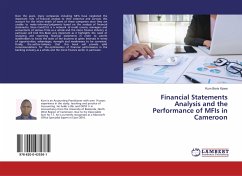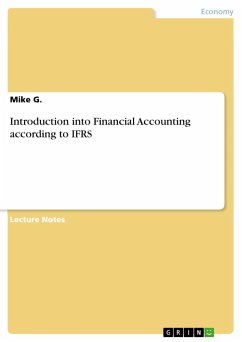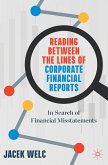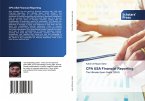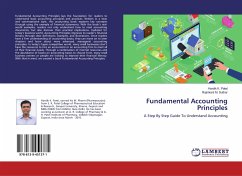- Gebundenes Buch
- Merkliste
- Auf die Merkliste
- Bewerten Bewerten
- Teilen
- Produkt teilen
- Produkterinnerung
- Produkterinnerung
Through a mixture of concepts and examples, the second edition of this book demystifies the variety of elements of financial accounting and uncovers the need-to-know information for certification in this field. This book covers the two aspects of financial statement analysis, namely quantitative and non-quantitative analysis. Unique to the second edition, the book will also cover Non-GAA- metrics and valuation accounting. Concluding with helpful and updated case studies, the book will appeal to students and academics of financial accounting.
Andere Kunden interessierten sich auch für
![Financial Statements Analysis and the Performance of MFIs in Cameroon Financial Statements Analysis and the Performance of MFIs in Cameroon]() Kum Boris KpweFinancial Statements Analysis and the Performance of MFIs in Cameroon36,99 €
Kum Boris KpweFinancial Statements Analysis and the Performance of MFIs in Cameroon36,99 €![Introduction into Financial Accounting according to IFRS Introduction into Financial Accounting according to IFRS]() Mike G.Introduction into Financial Accounting according to IFRS9,99 €
Mike G.Introduction into Financial Accounting according to IFRS9,99 €![Reading Between the Lines of Corporate Financial Reports Reading Between the Lines of Corporate Financial Reports]() Jacek WelcReading Between the Lines of Corporate Financial Reports60,99 €
Jacek WelcReading Between the Lines of Corporate Financial Reports60,99 €![Entrepreneurial Finance Entrepreneurial Finance]() Miranda S. LamEntrepreneurial Finance200,99 €
Miranda S. LamEntrepreneurial Finance200,99 €![CPA USA Financial Reporting CPA USA Financial Reporting]() Azhar ul Haque SarioCPA USA Financial Reporting68,99 €
Azhar ul Haque SarioCPA USA Financial Reporting68,99 €![Fundamental Accounting Principles Fundamental Accounting Principles]() Hardik K. PatelFundamental Accounting Principles36,99 €
Hardik K. PatelFundamental Accounting Principles36,99 €![Financial Diagnosis As A Business Decision-Making Tool Financial Diagnosis As A Business Decision-Making Tool]() Vanessa Murielle AllialyFinancial Diagnosis As A Business Decision-Making Tool26,99 €
Vanessa Murielle AllialyFinancial Diagnosis As A Business Decision-Making Tool26,99 €-
-
-
Through a mixture of concepts and examples, the second edition of this book demystifies the variety of elements of financial accounting and uncovers the need-to-know information for certification in this field. This book covers the two aspects of financial statement analysis, namely quantitative and non-quantitative analysis. Unique to the second edition, the book will also cover Non-GAA- metrics and valuation accounting. Concluding with helpful and updated case studies, the book will appeal to students and academics of financial accounting.
Hinweis: Dieser Artikel kann nur an eine deutsche Lieferadresse ausgeliefert werden.
Hinweis: Dieser Artikel kann nur an eine deutsche Lieferadresse ausgeliefert werden.
Produktdetails
- Produktdetails
- Verlag: Springer International Publishing / Springer International Publishing AG / Springer Nature Switzerla
- Second Edition 2022
- Seitenzahl: 500
- Erscheinungstermin: 1. November 2022
- Englisch
- Abmessung: 216mm x 153mm x 32mm
- Gewicht: 753g
- ISBN-13: 9783031156625
- ISBN-10: 3031156625
- Artikelnr.: 64545836
- Herstellerkennzeichnung Die Herstellerinformationen sind derzeit nicht verfügbar.
- Verlag: Springer International Publishing / Springer International Publishing AG / Springer Nature Switzerla
- Second Edition 2022
- Seitenzahl: 500
- Erscheinungstermin: 1. November 2022
- Englisch
- Abmessung: 216mm x 153mm x 32mm
- Gewicht: 753g
- ISBN-13: 9783031156625
- ISBN-10: 3031156625
- Artikelnr.: 64545836
- Herstellerkennzeichnung Die Herstellerinformationen sind derzeit nicht verfügbar.
Felix I. Lessambo is Adjunct Associate Professor at Fordham University, USA, where he teaches Corporate Tax and Audit & Assurance Services. He was an Associate Professor at Central Connecticut State University School of Business where he taught Financial Statements Analysis, Global Financial Reporting, and Law & Finance. He has practiced international tax, transfer pricing, and alternative investment management where he structured and advised on hedge funds and private equity cross-border transactions. He is the author of several books in finance including The International Banking System, The International Corporate Governance System, International Financial Institutions and Their Challenges, International Aspects of US Taxation System, Audit-Assurance Services & Forensics, Financial Statements: Analysis & Reporting, The US Banking System, Mergers in the Global Markets, International Finance, The US Mergers & Acquisitions: Legal & Financial Aspects, and International ProjectFinance: The Public-Private Partnership.
Part 1. Overview of Financial Statements and the Statement of Position.
Chapter 1. Overview of Financial Statements.
Chapter 2. Cash and Cash Equivalents.
Chapter 3. Short
Term Assets: Inventories.
Chapter 4. Account Receivables.
Chapter 5. Pre
Paid Expenses, Unearned Income and Other Current Assets.
Chapter 6. Short
Term Liabilities and Working Capital.
Chapter 7. Long
Term Assets: Plant, Property and Equipment.
Chapter 8. Long Term Assets: Intangibles.
Chapter 9. Long
Term Liabilities: Leases.
Chapter 10. Long
Term Liabilities: Pension and Post
Retirement Liabilities.
Chapter 11. Shareholders' Equity.
Part 2. The Statement of Income.
Chapter 12. Analysis of the Statement of Income.
Chapter 13. Other Comprehensive Income.
Chapter 14. The Sub
Statement of Retained Earnings.
Chapter 15. The Computation of the Taxable Income.
Part 3. The Statement of Cash Flows and Financial Ratios.
Chapter 16. Analysis of the Statements of Cash Flows.
Chapter 17. Financial Ratios Analysis.
Part 4. Pro
Forma Financial Statements.
Chapter 18. Forecasting Financial Statements' Analysis.
Part 5. Consolidated Financial Statements.
Chapter 19. Foreign Currency Accounting.
Chapter 20. Consolidated Financial Statements.
Chapter 21. Segment and Intermediary Financial Statements.
Chapter 22. IFRS and GAAP.
Part 6. Case Study.
Chapter 23. Apple and Microsoft Case Study¿.
Part 6: Non
GAAP Reporting & Earnings Management.
Chapter 24. Non
GAAP Reporting.
Chapter 25. Earnings Management through Excessive Reserves and Provisions.
Part 7: Valuation.
Chapter 26. Valuation Accounting.
Chapter 1. Overview of Financial Statements.
Chapter 2. Cash and Cash Equivalents.
Chapter 3. Short
Term Assets: Inventories.
Chapter 4. Account Receivables.
Chapter 5. Pre
Paid Expenses, Unearned Income and Other Current Assets.
Chapter 6. Short
Term Liabilities and Working Capital.
Chapter 7. Long
Term Assets: Plant, Property and Equipment.
Chapter 8. Long Term Assets: Intangibles.
Chapter 9. Long
Term Liabilities: Leases.
Chapter 10. Long
Term Liabilities: Pension and Post
Retirement Liabilities.
Chapter 11. Shareholders' Equity.
Part 2. The Statement of Income.
Chapter 12. Analysis of the Statement of Income.
Chapter 13. Other Comprehensive Income.
Chapter 14. The Sub
Statement of Retained Earnings.
Chapter 15. The Computation of the Taxable Income.
Part 3. The Statement of Cash Flows and Financial Ratios.
Chapter 16. Analysis of the Statements of Cash Flows.
Chapter 17. Financial Ratios Analysis.
Part 4. Pro
Forma Financial Statements.
Chapter 18. Forecasting Financial Statements' Analysis.
Part 5. Consolidated Financial Statements.
Chapter 19. Foreign Currency Accounting.
Chapter 20. Consolidated Financial Statements.
Chapter 21. Segment and Intermediary Financial Statements.
Chapter 22. IFRS and GAAP.
Part 6. Case Study.
Chapter 23. Apple and Microsoft Case Study¿.
Part 6: Non
GAAP Reporting & Earnings Management.
Chapter 24. Non
GAAP Reporting.
Chapter 25. Earnings Management through Excessive Reserves and Provisions.
Part 7: Valuation.
Chapter 26. Valuation Accounting.
Part 1. Overview of Financial Statements and the Statement of Position.- Chapter 1. Overview of Financial Statements.- Chapter 2. Cash and Cash Equivalents.- Chapter 3. Short-Term Assets: Inventories.- Chapter 4. Account Receivables.- Chapter 5. Pre-Paid Expenses, Unearned Income and Other Current Assets.- Chapter 6. Short-Term Liabilities and Working Capital.- Chapter 7. Long-Term Assets: Plant, Property and Equipment.- Chapter 8. Long Term Assets: Intangibles.- Chapter 9. Long-Term Liabilities: Leases.- Chapter 10. Long-Term Liabilities: Pension and Post-Retirement Liabilities.- Chapter 11. Shareholders' Equity.- Part 2. The Statement of Income.- Chapter 12. Analysis of the Statement of Income.- Chapter 13. Other Comprehensive Income.- Chapter 14. The Sub-Statement of Retained Earnings.- Chapter 15. The Computation of the Taxable Income.- Part 3. The Statement of Cash Flows and Financial Ratios.- Chapter 16. Analysis of the Statements of Cash Flows.- Chapter 17. Financial Ratios Analysis.- Part 4. Pro-Forma Financial Statements.- Chapter 18. Forecasting Financial Statements' Analysis.- Part 5. Consolidated Financial Statements.- Chapter 19. Foreign Currency Accounting.- Chapter 20. Consolidated Financial Statements.- Chapter 21. Segment and Intermediary Financial Statements.- Chapter 22. IFRS and GAAP.- Part 6. Case Study.- Chapter 23. Apple and Microsoft Case Study.
Part 1. Overview of Financial Statements and the Statement of Position.
Chapter 1. Overview of Financial Statements.
Chapter 2. Cash and Cash Equivalents.
Chapter 3. Short
Term Assets: Inventories.
Chapter 4. Account Receivables.
Chapter 5. Pre
Paid Expenses, Unearned Income and Other Current Assets.
Chapter 6. Short
Term Liabilities and Working Capital.
Chapter 7. Long
Term Assets: Plant, Property and Equipment.
Chapter 8. Long Term Assets: Intangibles.
Chapter 9. Long
Term Liabilities: Leases.
Chapter 10. Long
Term Liabilities: Pension and Post
Retirement Liabilities.
Chapter 11. Shareholders' Equity.
Part 2. The Statement of Income.
Chapter 12. Analysis of the Statement of Income.
Chapter 13. Other Comprehensive Income.
Chapter 14. The Sub
Statement of Retained Earnings.
Chapter 15. The Computation of the Taxable Income.
Part 3. The Statement of Cash Flows and Financial Ratios.
Chapter 16. Analysis of the Statements of Cash Flows.
Chapter 17. Financial Ratios Analysis.
Part 4. Pro
Forma Financial Statements.
Chapter 18. Forecasting Financial Statements' Analysis.
Part 5. Consolidated Financial Statements.
Chapter 19. Foreign Currency Accounting.
Chapter 20. Consolidated Financial Statements.
Chapter 21. Segment and Intermediary Financial Statements.
Chapter 22. IFRS and GAAP.
Part 6. Case Study.
Chapter 23. Apple and Microsoft Case Study¿.
Part 6: Non
GAAP Reporting & Earnings Management.
Chapter 24. Non
GAAP Reporting.
Chapter 25. Earnings Management through Excessive Reserves and Provisions.
Part 7: Valuation.
Chapter 26. Valuation Accounting.
Chapter 1. Overview of Financial Statements.
Chapter 2. Cash and Cash Equivalents.
Chapter 3. Short
Term Assets: Inventories.
Chapter 4. Account Receivables.
Chapter 5. Pre
Paid Expenses, Unearned Income and Other Current Assets.
Chapter 6. Short
Term Liabilities and Working Capital.
Chapter 7. Long
Term Assets: Plant, Property and Equipment.
Chapter 8. Long Term Assets: Intangibles.
Chapter 9. Long
Term Liabilities: Leases.
Chapter 10. Long
Term Liabilities: Pension and Post
Retirement Liabilities.
Chapter 11. Shareholders' Equity.
Part 2. The Statement of Income.
Chapter 12. Analysis of the Statement of Income.
Chapter 13. Other Comprehensive Income.
Chapter 14. The Sub
Statement of Retained Earnings.
Chapter 15. The Computation of the Taxable Income.
Part 3. The Statement of Cash Flows and Financial Ratios.
Chapter 16. Analysis of the Statements of Cash Flows.
Chapter 17. Financial Ratios Analysis.
Part 4. Pro
Forma Financial Statements.
Chapter 18. Forecasting Financial Statements' Analysis.
Part 5. Consolidated Financial Statements.
Chapter 19. Foreign Currency Accounting.
Chapter 20. Consolidated Financial Statements.
Chapter 21. Segment and Intermediary Financial Statements.
Chapter 22. IFRS and GAAP.
Part 6. Case Study.
Chapter 23. Apple and Microsoft Case Study¿.
Part 6: Non
GAAP Reporting & Earnings Management.
Chapter 24. Non
GAAP Reporting.
Chapter 25. Earnings Management through Excessive Reserves and Provisions.
Part 7: Valuation.
Chapter 26. Valuation Accounting.
Part 1. Overview of Financial Statements and the Statement of Position.- Chapter 1. Overview of Financial Statements.- Chapter 2. Cash and Cash Equivalents.- Chapter 3. Short-Term Assets: Inventories.- Chapter 4. Account Receivables.- Chapter 5. Pre-Paid Expenses, Unearned Income and Other Current Assets.- Chapter 6. Short-Term Liabilities and Working Capital.- Chapter 7. Long-Term Assets: Plant, Property and Equipment.- Chapter 8. Long Term Assets: Intangibles.- Chapter 9. Long-Term Liabilities: Leases.- Chapter 10. Long-Term Liabilities: Pension and Post-Retirement Liabilities.- Chapter 11. Shareholders' Equity.- Part 2. The Statement of Income.- Chapter 12. Analysis of the Statement of Income.- Chapter 13. Other Comprehensive Income.- Chapter 14. The Sub-Statement of Retained Earnings.- Chapter 15. The Computation of the Taxable Income.- Part 3. The Statement of Cash Flows and Financial Ratios.- Chapter 16. Analysis of the Statements of Cash Flows.- Chapter 17. Financial Ratios Analysis.- Part 4. Pro-Forma Financial Statements.- Chapter 18. Forecasting Financial Statements' Analysis.- Part 5. Consolidated Financial Statements.- Chapter 19. Foreign Currency Accounting.- Chapter 20. Consolidated Financial Statements.- Chapter 21. Segment and Intermediary Financial Statements.- Chapter 22. IFRS and GAAP.- Part 6. Case Study.- Chapter 23. Apple and Microsoft Case Study.


